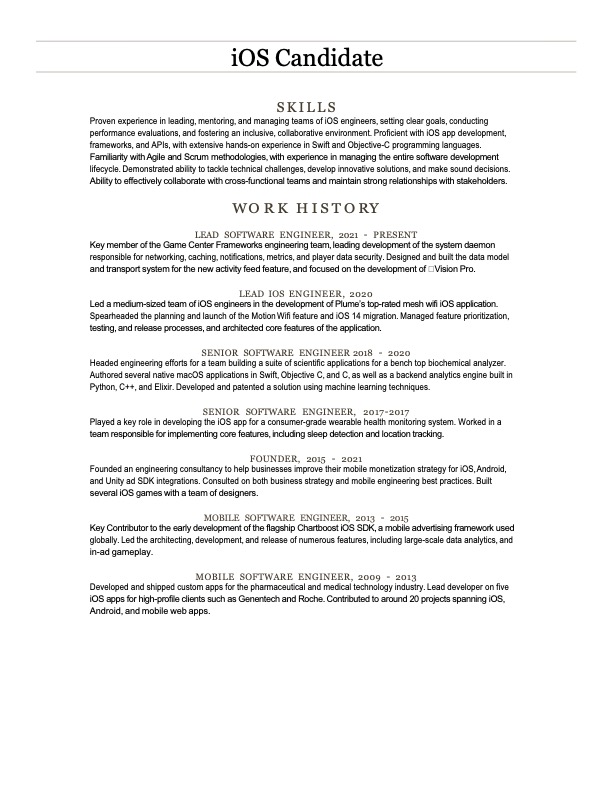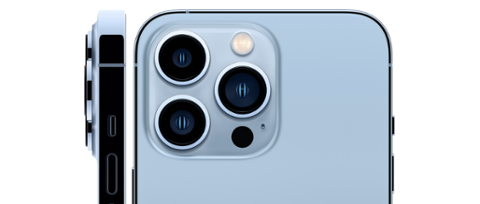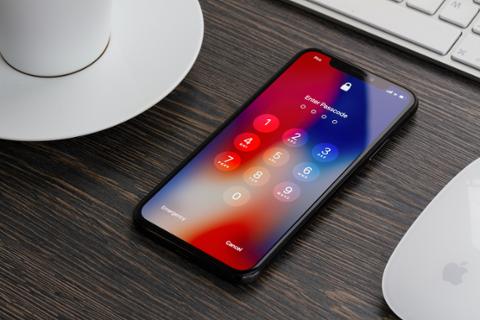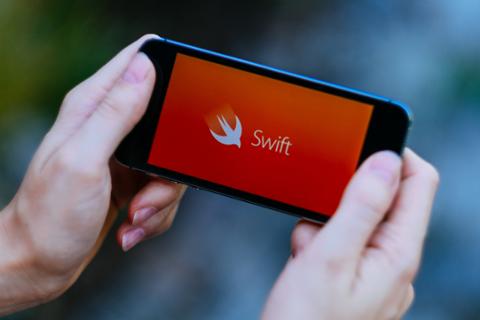If you’re interested in a career as an iOS developer, you must craft a resume (and cover letter) that highlights your technical skills, experience, and achievements in a clear and concise way. In addition, you must customize the resume for each position—for example, some jobs will require you to maintain a mountain of legacy Objective-C code, while others will ask you to push the limits of Swift, Apple’s newer language for iOS development.
In this article, we’ll break down what an iOS developer resume requires, along with content you should absolutely include, and a sample resume you can use as a template when crafting your own.
What do you need to include in an iOS developer resume?
Cory Althoff, senior vice president of software development programs at CompTIA, says that, from a development perspective, employers are looking for experience with Swift, Apple's programming language for building iOS applications, along with XCode, Apple's IDE for testing and distributing apps. Familiarity with cross-platform tools such as React Native is also a must for many potential employers.
When it comes to resume-writing, start by giving potential employers an overview of your skills and experience. “Before anything else, I start with a summary that helps a recruiter get an impression of who I am as a developer,” Althoff says. “If you can if you can write a professional summary in such a way that gives them a positive impression within the first two seconds, I think that's valuable.”
Like your cover letter, a professional overview gives you the chance to quickly show the “greatest hits” of your career, including some impressive statistics. For example, if you built an iOS app in your previous job that saved the company money or allowed it to double its revenue, you should absolutely mention that (as pithily as possible).
“For work experience, you want to list the things you accomplished, the tools you used, and detail specifically what your role was over the course of that application's development—for example if worked on a data pipeline for eBay using Python and Cassandra,” Althoff adds. “What technical decisions did you make on those projects?”
For a good idea of which skills to list, consult the original job posting. If a skill you know is mentioned in the job posting, make sure to include it in your resume—this will increase your chances of passing the automated screening used by many recruiters and hiring managers, as these tools hunt for specific keywords.
In general, the following terms tend to pop up in iOS job postings; keep these in mind as you craft the template resume you’ll later customize for specific positions:
- Swift
- Objective-C
- Software Engineering
- Software Development
- Xcode
- Unit Testing
- Git
- iOS Application Development
- Continuous Integration (CI)
- UIKit
- Xcode
- UIKit
A typical iOS developer job interview will drill into your mastery of these skills, with a big focus on practical applications. If you want some practice on potential questions, sites such as LeetCode will allow you to test your programming knowledge ahead of the interview.
Highlight your experience… as quickly as possible
Josh Drew, Regional Director at Robert Half in New England, says the most resumes start with the candidate’s work experience. It’s standard to list positions starting with the most recent; you also don’t need to include experience that’s especially old and outdated.
“We like to see anything that shows career progression,” he says. “Whatever shows technical and professional progression is going to be more relevant than listing a Merrill Lynch internship where you came in and worked six months.”
He adds that developers who can articulate their relevance and importance draw attention, no matter what the size of the company. Always make sure to tie your iOS projects to the company’s broader results; this will show recruiters and hiring managers that you’re able to work effectively with teams and deliver on strategy.
“Developers with smaller companies are typically working with stakeholders and potentially company owners and investors,” he points out. “There's a whole component of working in a tight knit situation and being able to demonstrate your communication and collaboration capabilities.”
As Drew also notes, it’s good to keep all this information relatively condensed—constrained to a few bullet points per employment stage, ideally—with the clearest focus on your most recent work experience.
Draw attention to your App Store experience (and successes)
If you can, highlight any statistics around the apps you’ve developed, ranging from amount of revenue accrued to the number of times the app was downloaded.
“If 500,000 people are using it, then at least there's some sort of scale that went there, which represents its own challenges, as opposed to if you just made an app by yourself,” Althoff notes. “The 500,000 download theoretical case is—without any research—likely to demonstrate you have the skills needed to get hired.”
Drew agrees that it’s critical to highly App Store successes. “That's a very common thing we see—when somebody has developed an application or been on a team where an app has made it onto the App Store,” he says. “They'll typically include that with a link or somehow give visibility into that app.”
In other words, as you craft your resume, highlight your mastery of the App Store (which is often a complicated and frustrating hub for many organizations). It can also prove helpful to include a link to your GitHub repo so a knowledgeable hiring manager can see your side projects, coding, and other work. Speaking of which…
Make sure to list side projects and soft skills
If you want to really stand out in a crowded field of applicants, take the time to highlight any side projects that demonstrate your versatility as a developer.
When Althoff got his first job as a software engineer, he didn't have a degree in computer science. To demonstrate his ability, he did a side project where he scraped data from Airbnb and Zillow to find the most profitable places for low mortgages.
“People really like talking about that in interviews,” he says. “Find a really cool side project that captures people's attention and highlight that in your resume. Stuff like that really helps you stand out.”
When it comes to listing soft skills, Drew says its critical to tie the “standard” soft skills such as communication and empathy to actual examples from your previous jobs.
“You may be working with investors and doing presentations and pitching on getting additional funding, or working on cross-functional teams,” he says. “Find examples where your critical thinking or creative skills have led to a project's success or how those skills were applied to the project or work environment.”
iOS developer resume template
It’s impossible to overstate the importance of crafting a resume to a specific position. People who create one resume and send it to dozens of jobs are likelier to face a high rate of rejection. Hiring managers and recruiters want to see how your skills and experience will benefit their specific company, and that means tailoring your resume to fit the requirements and needs expressed in the original job posting.
However, the work of customization will move much more quickly if you have a template to work from. To that end, check out this sample iOS developer resume below:

Customize as much as possible, list your most relevant skills and side projects, and always remember that your soft skills such as empathy and communication will matter just as much as your technical skills.
Related Resources:
Find everything you need on how to create the perfect tech resume.



